13 Best Indoor Plants and Care for Them
Ah, the great house interior design. We often overlook the places where we spend the most time (4+ hours a week alone in the bathroom!) when it comes to our favorite plants. Not each person has a natural green thumb, but that’s okay because there are plenty of hard-to-kill houseplants that come to the rescue when you’re looking to add a little greenery to your Living Room ideas. Sure, we’ve figured out some design inspiration the flower beds, window boxes, and backyard gardens, but what do you do if you want to bring some? green indoors? This article will help you which type of indoor plants best suit your interior.
Fortunately, there are several types of indoor plants that can fill your home décor ideas and require little work to keep them alive. While taking the time to care for a plant can be very rewarding, we understand that it’s easy to forget to give your plant the care it needs, understand what you can reasonably expect from houseplants (we’re looking at you orchids).
First, you’ll need to assess your space: is it a room that gets direct sunlight, indirect sunlight, or does it stay in the shade? Plants such as ponytail palm yucca, and jade like a sunny room while other species such as pothos, dracaena and prayer plants prefer more shady areas. If you prefer to play it safe and are looking for a maintenance-free plant, then artificial plants are for your Living Room Design. However, if you want to try live plants, scroll down our list for the best houseplants!
1-Rubber plant (Ficus elastica)
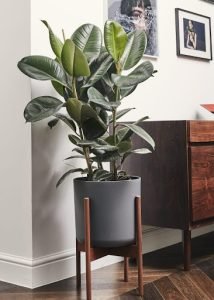
With glossy leaves and the ability to grow quite large, the rubber plant is a hardy specimen. There is no doubt that the large houseplant is pleasing to the eye, but these species are also very useful around the home. Those big, glossy leaves mean that this plant is all about getting down to business and cleaning your air of nasty toxins. Rubber trees are one of the most forgiving and low-maintenance houseplants as they can easily take a little neglect.
Rubber Plant Care:
Keep them alive with some bright, indirect light and some good water once a week.
2-Yucca plant (Yucca elephantipes)
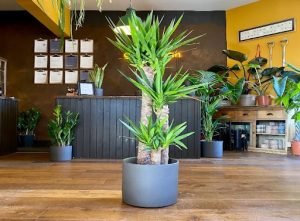
Yucca elephantipes is an easy-going, exotic houseplant that will grow equally in a semi-shaded, sunbaked, cool, and centrally heated roomb pot. Also available in variegated form, they are specially grown from trunk sections which, when planted, grow leaves and roots. Look for plants that have multiple trunks potted together in a pot for a sturdy form that will make an impressive display in a spacious modern interior design.
Yucca Plant Care:
Water liberally during the growing season, but then allow the compost dry out considerably before applying more. Water every two weeks from spring to fall.
3-Peace lily (Spathiphyllum wallisii)

Where ventilation is poor, the air we breathe becomes stale and stagnant. Air conditioning might solve the problem, but growing plants like the peace lily, which mimics the way nature cleans Earth’s atmosphere, is a great way to purify and revitalize the air. This plant with lush tropical foliage produces beautiful white sail-like flowers on stiff, erect stems.
Peace lily Plant Care:
Peace lilies need light to encourage white flowers to flourish, but not position it in direct sunlight.
4-Sabre fig (Ficus alii)
The overwhelming popularity of the fiddle leaf fig tree means that some of the more unusual and interesting figs are sometimes overlooked. With long, scrawny leaves reminiscent of an Australian native and a hardy, hardy nature, it’s time for Ficus longifolia to enjoy its moment in the spotlight. If you are looking for a great houseplant that will make a statement in your space, look no further. This is going to be the next big thing for sure.
Sabre Fig Plant Care:
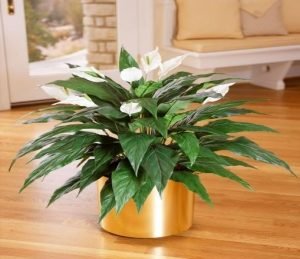
Care is quite easy, indirect bright light and a good amount of water about once a week should be given.
5-Winter bourn (Philodendron Xanadu)
Philodendrons (pictured above) grow up to three feet and are common houseplants that tolerate low light. The striking foliage reveals its tropical origin.
Winter bourn Plant Care:
Daily watering especially during summer.
6-Fiddle leaf fig (Ficus lyrata)
The fiddle leaf fig is a popular tall plant with fiddle-shaped leaves. It should be grown in a large pot in a well-lit area. It is a glossy indoor plants.
Fiddle Leaf Fig Plant Care:
Water regularly throughout the growing season but allow the soil to dry out between waterings during cooler months.
7-African milk thistle (Euphorbia trigona)
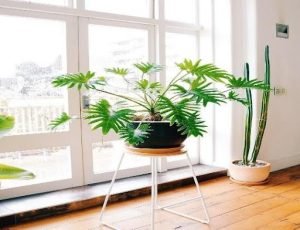
For those who like prickly and have a spot that gets plenty of light and even some morning sun, Euphorbia trigona makes a tall and impressive houseplant. Aside from the main stem, these succulents make an exotic addition to your plant group. They can be transplanted once a year if you really want to see them grow.
Milk Thistle Plant Care:
Fertilizing every few months also promotes growth. Water deeply and allow the water to drain easily and make sure they dry before watering again.Try these indoor plants.
8-Heart-leaf Philodendron (Philodendron cordatum)
That last bit of lush might not be the first tall houseplant you think of when you think of tall plants but give it enough time and those tendrils can get quite a good length. Heart leaf philodendrons work well placed on a plant stand and are perfect for the cascading plant effect. Even better, train them through walls with small transparent hooks for a beautiful green sculpture. Their heart shaped leaves unfurl in a lovely copper hue but ripen to a deep green.
Heart Leaf Philodendron Plant Care:
Again, bright indirect light is best, as is watering when the top few inches of soil are dry, about once a week.
9-Money plant (Crassula Arborescens)
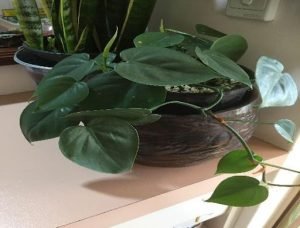
The Jade plant, Crassula Arborescens or the money plant is a decorative foliage plant that, when it is small can be used to add height to the succulent garden and when mature they add feature plant on a table in a sunny window. Available too as Golden Jade and Silver Jade.
Money Plant Care:
Water liberally during the active growing season, but always allow the top half of the compost to dry out before feeding more. From spring to early fall, feed well-established plants every two weeks with tomato fertilizer.
10-Snake plant (Sansevieria trifasciata)
In trend now is the snake plant Sansevieria trifasciata Laurentii, which has large, stiff, fleshy leaves that are gray green with lighter stripes and yellow edges. In fact, the entire Sansevieria clan has become very collectible. Sansevieria zeylanica has strong, broad, gray-green leaves streaked with a darker green, leading to its other popular name, “snake plant.”
Snake Plant Care:
Require water after month before they sulk.
11-Spider plant (Chlorophytum comosum)

The popular spider plant, Chlorophytum comosum ‘Variegatum’, likes a cool, bright spot out of direct sunlight, otherwise, its foliage will fade and weaken. The Lemon variety is a twist on the classic with vibrant lemon green foliage and Chlorophytum saundersiae Starlight has variegated, grassy foliage and small lily-like flowers.
Spider Plant Care:
In spring and summer, as the plant grows and produces seedlings, water freely, allowing the compost to nearly dry out between waterings. Spray the foliage frequently to keep the leaves clean.
12-Swiss cheese plant (Monstera deliciosa)
One of our all-time favorites for those graphic leaves and pits, Monstera makes a fabulous tall houseplant. This green beauty can grow nice and tall, so make sure it has plenty of room to stretch out. You’ll probably need to plant it as it grows for extra support and keep those gorgeous leaves dust free with a regular cloth, but all work is good and worth it.
Swiss Cheese Plant Care:
It will grow in bright conditions, indirect light, and good water once the top layer of soil is dry.
13-Bird of Paradise (Strelitzia reginae)
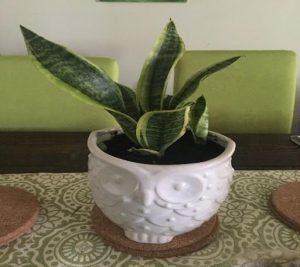
With amazing paddle-shaped leaves that are beautiful and shiny, this plant brings jungle vibes. It thrives in bright light and can tolerate some full sun. With enough sun, you might be rewarded with one of its spectacular blooms, from which the bird of paradise takes its name. But even without flora, this is a great houseplant.
Bird of Paradise Plant Care:
Provide enough water and light for better plant growth.
READ NEXT: How to Organize and Decorate Your L-shaped Living Room
RELATED TOPICS: home design

